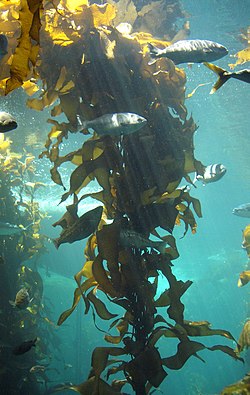Brown algae
class of algae From Wikipedia, the free encyclopedia
Remove ads
Brown algae are a large group of multicellular algae. All the brown algae are multicellular. Most brown algae have fucoxanthin, a chemical that gives them a brown color. They include many seaweeds in colder waters of the Northern Hemisphere. Most brown algae live in marine environments, where they play an important role both as food and as a potential habitat.
There are 2000 species of brown algae. Most species live in the ocean. They are important as food and as homes for many animals and marine life. Some brown algae are gathered by humans for food. The giant kelp Macrocystis is a brown alga that forms underwater forests, and it may grow to 60 meters. The Sargasso Sea gets its name from the Sargassum seaweed that floats on the surface. Many brown algae grow on rocks at the seashore.
Brown algae are unique among heterokonts in developing into multicellular forms with differentiated tissues. But they reproduce by means of flagellated spores and gametes that look like the cells of other heterokonts. Genetic studies show their closest relatives to be the yellow-green algae (Xanthophyceae).
Remove ads
Classification
This is a list of the orders in the class Phaeophyceae:[2]
|
|
Remove ads
References
Wikiwand - on
Seamless Wikipedia browsing. On steroids.
Remove ads

